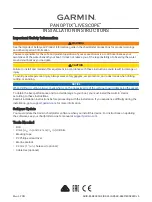
16
2) Use a 1-1/16” hole saw and drill the hole from the
outside of the hull. Sand or clean the area around the hole,
inside and outside to insure that the sealing compound will
adhere properly to the hull. Select a marine grade adhesive
sealant, such as 3M 5200, and use according to the
instructions.
3) Remove the bronze hex nut from the housing and cable.
4) Uncoil the transducer cable and thread it through the
hole into the inside of the hull.
DANGER: DO NOT apply
tension to the transducer cables as this may sever internal
connections.
5) Apply a 1/8” thick layer of sealant on the upper flat
surface of the transducer, bronze alignment pin and fairing
block (if used).
6) From the outside of the hull, push the housing into the
1” hole. Twist the housing slightly to squeeze out excess
sealant. Carefully confirm that the transducer is aligned so
that the round front end is pointed directly toward the front
of the boat.
7) Install and tighten the bronze hex nut (allow for swelling
in wooden hulls).
8) Remove excess sealant from the outside to assure
smooth water flow over the transducer.
DANGER: Wood hulls and fairing blocks will expand
after the boat is put back into the water, so it is important
that the transducer be only hand-tightened until the wood
fully expands. Otherwise the wood fairing block may
crack.
DANGER: Be sure to check for leaks when the boat is
placed in the water. Allow at least 24 hours after
installation for any leak to appear.
DANGER: If the boat is kept in saltwater it is
recommended that the transducer be coated with an anti-
fouling paint.
USE ONLY WATER BASED ANTI-
FOULING PAINT. DO NOT USE KETONE BASED
PAINTS. Ketone based anti-fouling paint will attack the
plastic materials used in the transducer. See page 34 for
recommendations.
Summary of Contents for iScan V90
Page 1: ...1...
Page 38: ...38 Notes...



































